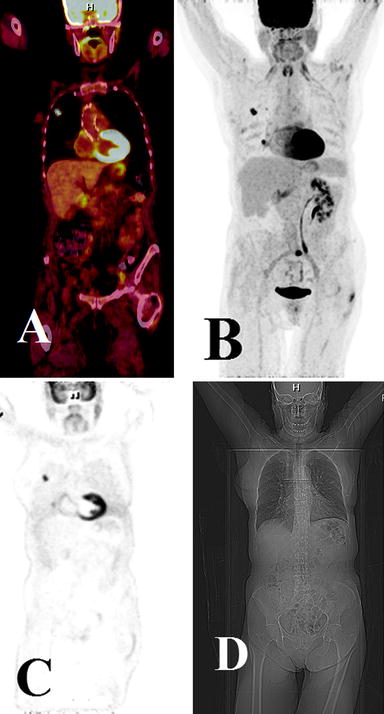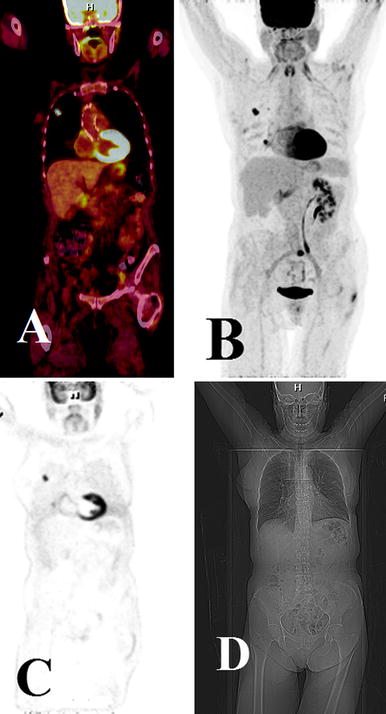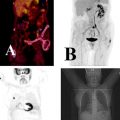and Adam Sciuk2
(1)
Department of Nuclear Medicine, Resurrection Medical Center, Chicago, IL, USA
(2)
Department of Radiology, Resurrection Medical Center, Chicago, IL, USA
Abstract
Answers to Test #1 begin on page 45
Questions
1.
The exposure rate of an activity of 1 millicurie (mCi) measured at 1 centimeter (cm) is called:
(A)
Roentgen man equivalent (REM)
(B)
The exposure rate constant (ERC)
(C)
Total effective dose equivalent (TEDE)
(D)
Kilobecquerel (kBq)
2.
Quantitative bias that refers to the underestimation of counts density which differs from what they should be is called:
(A)
Motion artifact
(B)
Partial-volume effect
(C)
Recovery coefficient
(D)
Truncation artifact
3.
Truncation artifacts in PET/CT imaging are produced by:
(A)
Contrast medium
(B)
Difference in size of FOV between PET and the CT
(C)
Difference in scanning time between PET and the CT
(D)
Beds overlapping
4.
Dental fillings, hip prosthetics, or chemotherapy port are examples of PET/CT imaging artifacts described as:
(A)
Truncation artifacts
(B)
Motion artifacts
(C)
Contrast medium artifacts
(D)
Metallic implants artifacts
5.
Property of PET detectors that allows them faster timing signals for coincidence detection and to work at high count rates is called:
(A)
The stopping power
(B)
Energy resolution
(C)
The decay constant
(D)
The light output
6.
The picturing, description, and measurement of biological processes at the particle and cellular level is known as:
(A)
Dynamic imaging
(B)
Molecular imaging
(C)
Static imaging
(D)
Dual point imaging
7.
A PET system capacity to distinguish between two points after image reconstruction is called:
(A)
Contrast
(B)
Resolution
(C)
Attenuation
(D)
Emission
8.
Allergic reaction that begins within seconds/minutes of contrast media administration and rapidly progresses to cause airway constriction, skin and intestinal irritation, and altered heart rhythms is called:
(A)
Urticaria
(B)
Anaphylaxis
(C)
Sepsis
(D)
Infarction
9.
The first PET radiopharmaceutical to receive the U.S. Food and Drug Administration approval in 1989 was:
(A)
Rb-82
(B)
F-18 Fluoride
(C)
F-18 FDG
(D)
N-13 ammonia
10.
Choose from the following responses to interpret this ECG:
(A)
Normal sinus rhythm
(B)
Electronic ventricular pacemaker
(C)
Atrial fibrillation
(D)
Ventricular bigeminy (Fig. 2.1)
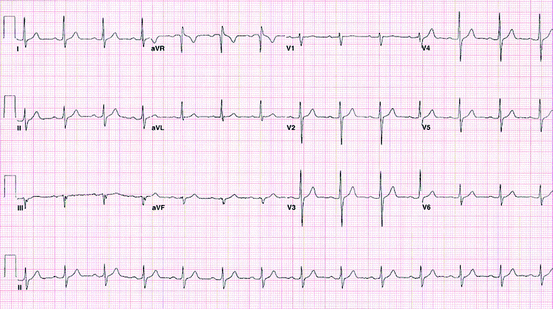

Fig. 2.1
ECG Sample Case: A 51-year-old man with atypical chest pain
11.
The dose calibrator quality control procedure performed to assess the device’s ability to measure accurately a range of a low to high activities is called:
(A)
Geometry
(B)
Accuracy
(C)
Linearity
(D)
Constancy
12.
The following positron-emitting radionuclides are isotopes of natural elements present in most biochemical processes EXCEPT:
(A)
O-15
(B)
F-18
(C)
C-11
(D)
N-13
13.
Two photons arising from the same annihilation event and detected by two detectors within the coincidence time-window are:
(A)
True coincidences
(B)
Random events
(C)
Scatter coincidences
(D)
Single events
14.
Which of the following serve as the building blocks for proteins synthesis?
(A)
Amino acids
(B)
Phospholipids
(C)
Enzymes
(D)
Hormones
15.
Positronium (Ps) is an arrangement of:
(A)
Two positrons
(B)
Two electrons
(C)
An electron and a positron
(D)
A positron and a neutrino
16.
Which of the following regions is the most common site of brown fat localization?
(A)
Neck
(B)
Mediastinum
(C)
Paravertebral
(D)
Perinephric
17.
Which of the following scintillators commonly used in PET imaging has the highest stopping power?
(A)
LSO (lutetium oxyorthosilicate)
(B)
BaF2 (barium fluoride)
(C)
BGO (bismuth germinate)
(D)
GSO (gadolinium orthosilicate)
18.
A malignant neoplasm of the skin linked with approximately 75% of skin cancer–related mortality is called:
(A)
Basal cell carcinoma
(B)
Sarcoma
(C)
Melanoma
(D)
Squamous cell carcinoma
19.
PET tracers have demonstrated significant potential utility and application in the following clinical areas EXCEPT:
(A)
Oncology
(B)
Cardiology
(C)
Pulmonology
(D)
Neurology
20.
A dose of F-18 FDG is calibrated to have 14 mCi at 12:00 p.m. How many milicuries of F-18 FDG will be remaining at 12:40 p.m.?
(A)
2.6 mCi
(B)
11 mCi
(C)
18 mCi
(D)
19.6 mCi
21.
The sum of the weighted equivalent doses in all the tissues and organs of the body is called:
(A)
Whole-body dose
(B)
Effective dose
(C)
Committed dose equivalent
(D)
Shallow dose equivalent
22.
The combined whole-body effective dose for a clinically diagnostic PET/CT is typically in the range:
(A)
<10 mSv
(B)
10–20 mSv
(C)
20–30 mSv
(D)
>30 mSv
23.
The positron has the same mass as an electron and an electric charge of:
(A)
–2
(B)
−1
(C)
0
(D)
+1
24.
The initial diagnosis of melanoma is established by:
(A)
PET examination
(B)
CT examination
(C)
Histologic evaluation
(D)
Dermatologist evaluation
25.
In PET scanning process raw data acquired and identified as coincidence events along their LOR are stored in the raw data format called:
(A)
Histograms
(B)
Sinograms
(C)
Dextrograms
(D)
Pictograms
26.
Which of the following is cyclotron produced positron-emitting radionuclide?
(A)
Copper-62
(B)
Nitrogen-13
(C)
Gallium-68
(D)
Rubidium-82
27.
A piece of equipment that sorts out photons of different radionuclides with different photon energies and to separate scattered photons from the useful ones is called:
(A)
Photomultiplier tube
(B)
Pulse height analyzer
(C)
ADC converter
(D)
Optical window
28.
DNA synthesis is a measure of cellular:
(A)
Apoptosis
(B)
Mutation
(C)
Proliferation
(D)
Metabolism
29.
The F-18 fluoride bone uptake mechanism is similar to that of:
(A)
F-18 fluorodeoxyglucose (FDG)
(B)
Ga-68
(C)
Tc-99 m methylenediphosphonate (MDP)
(D)
In-111
30.
The process by which new blood vessels are formed is called:
(A)
Angiogenesis
(B)
Embryogenesis
(C)
Morphogenesis
(D)
Organogenesis
31.
Which of the following quality control procedures are required for proper functioning of the survey meter?
(A)
Calibration and linearity
(B)
Geometry and constancy
(C)
Calibration and constancy
(D)
Linearity and geometry
32.
The Circle of Willis is a circle of arteries that supply blood to:
(A)
The heart
(B)
The lungs
(C)
The brain
(D)
The liver
33.
The CT X-ray tube:
(A)
Detects the X-ray
(B)
Produces the X-ray
(C)
Shields from the X-ray
(D)
Measures the X-ray
34.
The radiodensity of distilled water at standard pressure and temperature (STP) on the Hounsfield unit (HU) scale is equal to:
(A)
−1 HU
(B)
0 HU
(C)
1 HU
(D)
10 HU
35.
The dose calibrator quality control procedure testing a long-lived standard at each of the frequently used radionuclides settings is called:
(A)
Geometry
(B)
Accuracy
(C)
Linearity
(D)
Constancy
36.
Which of the following radionuclides commonly used in PET imaging has the highest energy?
(A)
Carbon-11
(B)
Nitrogen-13
(C)
Oxygen-15
(D)
Fluorine-18
37.
The PET scanner quality control procedure in which data are used with the transmission data in the computation of attenuation correction factors is called:
(A)
Normalization
(B)
Calibration
(C)
Blank scan
(D)
Attenuation correction
38.
The property of the scintillation detector described as the number of scintillations produced by each incident photon is called:
(A)
The stopping power
(B)
Energy resolution
(C)
The decay constant
(D)
The light output
39.
Which of the following compounds serves as a precursor for the synthesis of phospholipids?
(A)
Thymidine
(B)
Acetate
(C)
Choline
(D)
Tyrosine
40.
What is the percent error of the dose calibrator reading if a 4 ml reference volume (expected) of geometry test reads 2.8 mCi, and the actual reading obtained in 10 ml volume is 2.5 mCi?
(A)
12%
(B)
10.7%
(C)
−10.7%
(D)
−12 %
41.
The presented images labeled A, B, C, and D were obtained during a routine PET/CT scan. The image labeled “A” is described as:
(A)
Topogram
(B)
Fused coronal
(C)
Non-attenuation corrected
42.
Which of the following is the correct order of scanning when a typical PET/CT protocol is applied?
(A)
Transmission CT, emission PET, topogram
(B)
Transmission CT, topogram, emission PET
(C)
Topogram, transmission CT, emission PET
(D)
Emission PET, transmission CT, topogram
43.
Presence of the non-collinearity of the annihilation photons and the finite positron range are inherent properties of positron emission tomography resulting in:
(A)
Attenuation artifacts
(B)
Positional inaccuracy
(C)
Scatter
(D)
Truncation
44.
Which of the following positron-emitting nuclides has the shortest half-life?
(A)
Rubidium-82
(B)
Oxygen-15
(C)
Nitrogen-13
(D)
Carbon-11
45.
The cathode filament of the X-ray tube:
(A)
Emits electrons
(B)
Emits X-ray
(C)
Attracts electrons
(D)
Detects X-ray
46.
An oncology patient referred for a positron emission tomography scan should fast prior to his/her appointment for at least:
(A)
12 h
(B)
8 h
(C)
4 h
(D)
2 h
47.
Daily quality control checks on the PET scanner should be performed:
(A)
After the last procedure
(B)
During the uptake phase
(C)
At the end of the day
(D)
Before the patient is injected
48.
Patients with malignant melanoma should be scanned with their arms:
(A)
Down
(B)
Crossed over the chest
(C)
Up
(D)
Beneath the patient
49.
The presence of asbestos-related plaques, benign inflammatory pleuritis, tuberculous pleuritis, and pleural effusion can result in:
(A)
False-positive uptake in FDG-PET images of patients with malignant mesothelioma
(B)
True-positive uptake in FDG-PET images of patients with malignant mesothelioma
(C)
FDG-PET attenuation artifacts
(D)
FDG-PET motion artifacts
50.
A 13 mCi dose of F-18 FDG is calibrated for 12:00 p.m. If the patient comes an hour early, how many millicuries will there be in the dose?
(A)
3.6 mCi
(B)
9 mCi
(C)
19 mCi
(D)
46 mCi
51.
The earliest disposal of the decay-in-storage waste material is permitted if it was held for a minimum 10 half-lives and has decayed to less than:
(A)
Background level
(B)
Two times background levels
(C)
0.05 mR/h
(D)
0.5 mR/h
52.
Organizing, problem solving, attention, and planning are controlled by the:
(A)
Frontal lobe of the brain
(B)
Occipital lobe of the brain
(C)
Parietal lobe of the brain
(D)
Temporal lobe of the brain
53.
The recommended time interval for PET imaging after biopsy is:
(A)
1 week
(B)
2–4 weeks
(C)
2–6 months
(D)
> 6 months
54.
The example of the anatomic diagnostic modality employed in the work-up of the patient with seizures is:
(A)
Electroencephalography (EEG)
(B)
Positron emission tomography (PET)
(C)
Magnetic resonance imaging (MRI)
(D)
Single-photon emission computed tomography (SPECT)
55.
In the PET/CT acquisition, the CT component is performed for:
(A)
Scatter correction
(B)
Attenuation correction
(C)
Motion correction
(D)
Random correction
56.
A series of organized, involuntary, smooth waves of muscular contractions of the alimentary canal is called:
(A)
Diverticulosis
(B)
Peristalsis
(C)
Cramps
(D)
Paralysis
57.
Standardized uptake value (SUV) measurements are performed on:
(A)
Non-attenuation-corrected (NAC) images only
(B)
Attenuation-corrected (AC) images only
(C)
Non-attenuation-corrected (NAC) and attenuation-corrected (AC) images
(D)
Attenuation-corrected (AC) or non-attenuation-corrected (NAC) images
58.
Which of the following positron-emitting nuclides has the longest half-life?
(A)
Fluorine-18
(B)
Oxygen-15
(C)
Nitrogen-13
(D)
Carbon-11
59.
False-negative PET scans in lung cancer imaging occur predominantly because of:
(A)
Lesions that are too big to be evaluated by PET
(B)
Lesions that are too superficial to be evaluated by PET
(C)
Lesions that are too small to be evaluated by PET
(D)
Lesions that are too deep to be evaluated by PET
60.
The presented CT image Fig. 2.3 is an example of an artifact described as a:
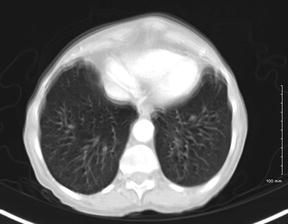

Fig. 2.3
CT axial slice
(A)
Beam hardening artifact
(B)
Contrast media artifact
(C)
Motion artifact
(D)
Streak artifact
61.
The principal measure of reducing radiation exposure to patients during PET/CT examination is reduce the:
(A)
Peak kilovoltage
(B)
Product of beam current and exposure time
(C)
Beam current
(D)
Product of beam current and peak kilovoltage
62.
A minimally invasive surgical procedure used to detect the presence or absence of occult regional nodal metastases in patients without clinically noticeable nodal disease is called:
(A)
Lymphoscintigraphy
(B)
Sentinel node scintigraphy
(C)
Sentinel node biopsy
(D)
Lymph nodes mapping
63.
According to minimal performance standards, the FDG uptake period that is required to minimize variability in SUV quantification should be at least:
(A)
30 min
(B)
45 min
(C)
60 min
(D)
75 min
64.
Lung activity observed on F-18 FDG-PET/CT imaging:
(A)
Is more prominent on attenuation-corrected images
(B)
Increases from the posterior to the anterior segments
(C)
Increases from the inferior to the superior segments
(D)
Is more prominent on non-attenuation-corrected images
65.
Which of the following methods, in clinical practice, is the most commonly applied to determine SUV?
(A)
Isocontour ROIs
(B)
Manual ROIs
(C)
SUV max
(D)
SUV peak
66.
CT and PET scans demonstrate different aspects of disease indicating regions with:
(A)
Altered metabolism (PET) and areas of structural change (CT)
(B)
Altered metabolism (CT) and areas of structural change (PET)
(C)
Altered metabolism (PET) and areas of structural change (PET)
(D)
Altered metabolism (CT) and areas of structural change (CT)
67.
If the pretest probability of disease is high and then a negative PET is more likely to be:
(A)
False negative
(B)
False positive
(C)
True negative
(D)
True positive
68.
Multiple focal cortical and subcortical defects on FDG study indicate diagnosis of:
(A)
Vascular dementia
(B)
Alzheimer’s disease
(C)
Parkinson’s disease
(D)
Radiation necrosis
69.
The process of aligning images so that corresponding features can easily be related is called:
(A)
Image smoothing
(B)
Image filtering
(C)
Image registration
(D)
Image processing
70.
The NRC requires that all wipe tests be recorded in disintegrations per minute (dpm). If 230 net counts per minute (cpm) were acquired with 86% well counter efficiency, what is the result of the wipe test in disintegrations per minute (dpm)?
(A)
37 dpm
(B)
198 dpm
(C)
267 dpm
(D)
344 dpm
71.
The concept of clinical SPECT/CT system can be described as:
(A)
A single-head scintillation camera positioned in front of a CT scanner
(B)
A dual-head scintillation camera positioned in front of a CT scanner
(C)
A CT scanner positioned in front of a dual-head scintillation camera
(D)
A CT scanner positioned in front of a single-head scintillation camera
72.
A normal, physiological uptake of F-18 FDG in the stomach can be described as:
(A)
Distal stomach uptake is higher than proximal stomach uptake
(B)
Anterior stomach uptake is higher than posterior stomach uptake
(C)
Proximal stomach uptake is higher than distal stomach uptake
(D)
Posterior stomach uptake is higher than anterior stomach uptake
73.
The recommended time interval for PET-FDG imaging after chemotherapy is:
(A)
1 week
(B)
> 10 days
(C)
2–6 months
(D)
> 6 months
74.
An area of focal FDG uptake in the lungs, without corresponding finding on CT scan, most likely represents:
(A)
Pulmonary nodule
(B)
Radiation necrosis
(C)
An injected blood clot
(D)
Rib fracture
75.
The display shown in Fig. 2.4 presents attenuation-corrected and reconstructed positron emission tomography (PET-FDG) viability study. The reoriented tomographic slices are:
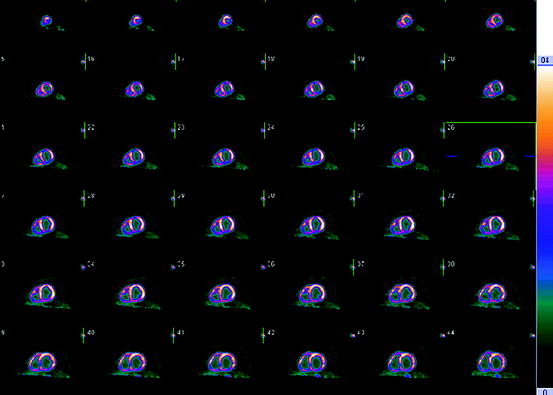

Fig. 2.4
PET/CT-FDG viability study
(A)
Short-axis slices
(B)
Vertical long-axis slices
(C)
Oblique short-axis slices
(D)
Horizontal long axis
76.
A hyperinsulinemic state affects the diagnostic quality of FDG-PET imaging and it is typically associated with:
(A)
Diffuse liver and splenic uptake
(B)
Diffuse muscular and myocardial uptake
(C)
Diffuse stomach and pancreatic uptake
(D)
Diffuse brown fat and brain uptake
77.
Malignant tumors of the chest wall include all of the following EXCEPT:
(A)
Lipoma
(B)
Chondrosarcoma
(C)
Osteosarcoma
(D)
Ewing sarcoma
78.
A group of lung diseases characterized by chronic obstruction of lung airflow that interferes with normal breathing and is not fully reversible is called:
(A)
Chronic bronchitis
(B)
Emphysema
(C)
Chronic obstructive pulmonary disease
(D)
Hospital acquired pneumonias
79.
The beta-amyloid uptake can be assessed through positron emission tomography (PET) using the radiopharmaceutical:
(A)
Carbon-11-labeled Pittsburgh Compound B (C-11 PiB)
(B)
Fluor-18 fluoromisonidazole (F-18 MISO)
(C)
Fluor-18-3-fluorothymidine (F-18FLT)
(D)
Carbon-11-labeled methionine (C-11 Met)
80.
Calculate the effective half-life of a radiopharmaceutical using the following information:
Physical half-life is 110 min
Biological half-life is 360 min
(A)
470 min
(B)
235 min
(C)
84.3 min
(D)
3.2 min
81.
Which of the following scintillators has the highest light output?
(A)
LSO (lutetium oxyorthosilicate)
(B)
NaI (Tl) (thallium-doped sodium iodide)
(C)
BGO (bismuth germinate)
(D)
GSO (gadolinium orthosilicate)
82.
The main organs of the digestive system include:
(A)
Teeth
(B)
Liver
(C)
Pancreas
(D)
Pharynx
83.
F-18 FDG-PET is considered as a superior modality, compared with CT, for evaluating posttreatment response in lymphoma patients because of:
(A)
The ability to provide anatomical information
(B)
The ability to differentiate viable tumor from fibrosis
(C)
Higher resolution
(D)
Shorter imaging
84.
Which of the following types of non-Hodgkin lymphomas is most common?
(A)
Burkitt’s lymphoma
(B)
Lymphoblastic lymphoma
(C)
Diffuse large B-cell lymphoma
(D)
Anaplastic large T-cell/null cell lymphoma
85.
The major limitation of PET in the head and neck imaging is its:
(A)
Poor sensitivity
(B)
Poor spatial resolution
(C)
Prolonged scanning time
(D)
Radiation exposure
86.
The most common cell type found in lymphoid tissue is:
(A)
Lymphocyte
(B)
Stem cell
(C)
Erythrocyte
(D)
Monocyte
87.
In order to achieve precise attenuation correction data for transmission scan they should be obtained using:
(A)
Low-dose CT
(B)
High-dose CT
(C)
Germanium-68
(D)
Cobalt-56
88.
Hiatal hernias can cause large foci of increased F-18 FDG uptake in/at:
(A)
The hilar region
(B)
The gastroesophageal junction
(C)
The pyloric sphincter
(D)
The stomach fundus
89.
The lymphoma that has come back after it has been treated is called:
(A)
Aggressive
(B)
Intermittent
(C)
Indolent
(D)
Recurrent
90.
The diagram for the process of positron–electron annihilation is shown in Fig. 2.5. Which of the following labels identifies the annihilation photon(s)?
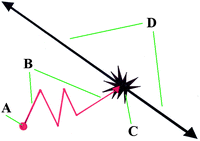

Fig. 2.5
Positron–electron annihilation diagram. Illustration by Sabina Moniuszko
(A)
D
(B)
C
(C)
B
(D)
A
91.
The use of a low-dose CT scan in place of a conventional PET transmission scan:
(A)
Increases the scan duration
(B)
Reduces confidence of the scan interpretation
(C)
Decreases throughput
(D)
Improves accuracy of the scan interpretation
92.
The one of disadvantages of nuclear medicine study over PET-FDG study in infection and inflammation imaging lies in its:
(A)
Low resolution
(B)
Faster time to results
(C)
Quantitation abilities
(D)
High sensitivity
93.
Dual time point FDG-PET imaging is reflecting:
(A)
The dynamics of lesion glucose metabolism
(B)
The dynamics of lesion growth
(C)
The dynamics of blood pool glucose clearance
(D)
The dynamics of blood pool activity
94.
Clinical stress perfusion studies with Rb-82 are usually limited to pharmacologic stress because of Rb-82’s:
(A)
High kinetic energy
(B)
Short half-life
(C)
Positron range
(D)
High cost
95.
Image-guided transthoracic needle aspiration or biopsy can be achieved with all of the following EXCEPT:
(A)
Computed tomography (CT)
(B)
Positron emission tomography (PET)
(C)
Fluoroscopy
(D)
Ultrasonography (USG)
96.
Stomach reflux disease can result in increased FDG uptake in/at:
(A)
The hilar region
(B)
The gastroesophageal junction
(C)
The pyloric sphincter
(D)
The stomach fundus
97.
The use of PET gating for specific applications in PET/CT scanning:
(A)
Reduces motion artifacts
(B)
Increases scanning time
(C)
Increases spatial resolution
(D)
Decreases sensitivity
98.
The lymphatic system is not a separate system of the body, but it is considered a part of the:
(A)
Digestive system
(B)
Hematopoietic system
(C)
Circulatory system
(D)
Respiratory system
99.
All of the following positron emission tomography myocardial perfusion tracers are cyclotron produced EXCEPT:
(A)
Water O-15
(B)
Rubidium Rb-82
(C)
Acetate C-11
(D)
Ammonia N-13
100.
The presented images labeled A, B, C, and D were obtained during a routine PET/CT scan. The image labeled “B” is described as:
(A)
Topogram
(B)
Fused coronal
(C)
Non-attenuation corrected
101.
All of the following are examples of conventional diagnostic imaging procedures that evaluate normal anatomy via radiologic images EXCEPT:
(A)
X-ray
(B)
Ultrasonography
(C)
Magnetic resonance imaging
(D)
Positron emission tomography
102.
The cerebellum is located posteriorly just below the cerebrum and is responsible for the proper control of:
(A)
Body temperature
(B)
Skeletal muscles
(C)
Emotions
(D)
Vision
103.
A topographic image of the body used to confirm proper patient positioning is called:
(A)
The blank scan
(B)
The scout scan
(C)
The delayed scan
(D)
The rescan
104.
The TNM (tumor, node, metastasis) staging system that is generally used for solid tumors is not applicable to lymphoma, since:
(A)
Lymphoma spreads in a predictable pattern
(B)
Lymphoma is a rapidly progressing disease
(C)
Lymphoma begins in multiple sites simultaneously
(D)
Lymphoma spreads in an unpredictable pattern
105.
Rb-82 is a monovalent cationic analog of potassium and has a biologic activity similar to:
(A)
Gallium Ga-67
(B)
Thallium Tl-201
(C)
Technetium Tc-99 m
(D)
Fluorine F-18
106.
A pulmonary nodule (PN) is defined as a separate opacity that is entirely surrounded by lung parenchyma and has a diameter of:
(A)
4 cm or less
(B)
3 cm or less
(C)
2 cm or less
(D)
1 cm or less
107.
Which of the following positron emission tomography myocardial perfusion tracers is described as a model tracer for flow quantitation?
(A)
Water O-15
(B)
Rubidium Rb-82
(C)
Acetate C-11
(D)
Ammonia N-13
108.
Get Clinical Tree app for offline access

All of the following diagnostic procedures can be utilized to evaluate patients with lymphoma EXCEPT:
(A)
Ga-67 scintigraphy
(B)
Bone marrow biopsy

